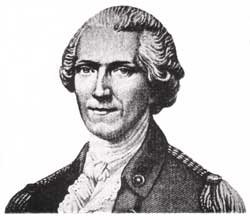Two weeks ago, we asked you to tell us about the folks who got buildings, streets and schools named after them. We got some great responses from a few of you, but Charlene Mayo took the cake. She did some great research and told us all about these famous people. For her hard work, she’ll get a $25 gift certificate to Butter’s Fine Food and Wine. YUM! Here are her answers:
White Park
Armenia Hobbs White and Nathaniel White were longtime Concord residents who put their time, money and influence into the causes that promoted the betterment of their fellow citizens.
Nathaniel was a partner in a prosperous credit card company and the Whites once owned the city’s water system.
The Whites helped establish the Centennial Home and the Franklin Orphans Home and gave generously to the White Memorial Universalist Church, the Concord Female Charitable Society, the Concord Equal Rights Association, women’s suffrage and the Concord Reform Club (a temperance organization).
Armenia gave the city the land for White Park in 1884, four years after her husband’s death. Because of the Whites, we have White Street, White Park, and White Farm on Clinton Street. The latter is said to have been a stop on the underground railroad.
Walker School
Timothy and Sarah Walker helped settle Concord (Rumford) about 1726. Timothy was the first parson in the settlement. He and Sarah had one son who became a judge and four other children, one of whom died in early childhood.
A garrison was built around their house and other houses near them in 1739 to guard the neighborhood from Indian raids.
A trust fund, the Timothy and Abigail Walker Lecture Fund, provides wonderful entertainment to the residents of Concord to this day. Concord has Walker Street and Walker School. The school was built on the site of the Old North Church in 1873 after the church burned down three years before.
Rumford Street
Count Rumford, also known as Benjamin Thompson, was a British loyalist during the Revolutionary War. He married Sarah Walker, daughter of Parson Timothy and Sarah Walker, after the younger Sarah’s first husband, Benjamin Rolfe, died. Benjamin was driven out of the city because of his political leanings in late 1772 and took refuge in Europe after he was threatened with being tarred and feathered.
Subsequently, he received the honor of being named count for his efforts in creating workhouses for the poor. He took the name “Count Rumford” in honor of Concord, which had previously been known as Rumford.
Count Rumford created the Rumford Chair of the Application of Science to Useful Arts at Harvard.
Rumford Baking Powder was created, patented and named for the count, and the label bears his likeness in profile. Concord has Rumford Street, Rumford Schools; and it had Rolfe and Rumford Home and Rumford Garrison No. 2 in East Concord.
Eastman School
Ebenezer Eastman was born in Haverhill, Mass., in 1681 and was among the first of 119 men to petition Massachusetts to settle here and start a town. He was a successful farmer, civic leader, militia officer and mill owner. He and 13 settlers were assigned to live within Rumford Garrison No. 2 in 1746. Ebenezer and his wife Sarah had eight children. He was a selectman for 14 years and often served as moderator. Eastman led soldiers in the capture of France’s Fortress Louisburg. When he died in 1748, he was the town’s richest man. His home, known as “The Fort,” vanished, but seven years later his son Philip built “Elm Croft” in the same area that is now known at Eastman Street. The house faced the landing for Eastman’s Ferry, which linked the East Village with the main settlement. The ferry, established by Ebenezer, crossed the Merrimack River by today’s railroad bridge. Eastman School is one of the places named in honor of this family. The Eastman monument still stands on Eastman Street.
Stickney Avenue
There have been several Stickneys of note. In 1794, John and Joseph Stickney owned and ran a tavern on the east side of Main Street. John P. Stickney ran a stable yard when the Merrimack River was heavily used to move freight, coaches were carrying people through Concord to other destinations and people needed places to stay, dine and put their horses up.
Because of the Stickneys, we have the Stickney Block and Stickney Avenue.
Ralph Pill building
Ralph Pill was a Lithuanian immigrant who established Ralph Pill Electrical Supply Co. in 1919. In Concord, the company is located at 22 Bridge St. in the Ralph Pill Building/Marketplace.
Alfred E. Pill, Ralph’s son, has been company president for more than 50 years. This successful company has stores and lighting showrooms throughout New Hampshire, Maine and Massachusetts.
Prior to the renovations to the Ralph Pill building, the tower sported a tree growing out of the top!










